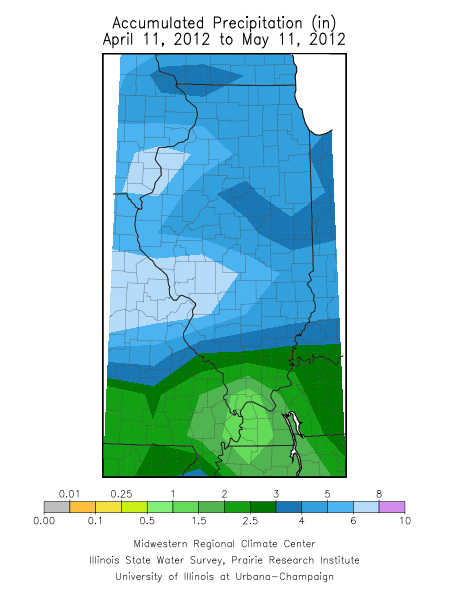Observed soil moisture data are collected at 19 sites in Illinois by the Illinois State Water Survey’s Water and Atmospheric Monitoring program. The soil moisture is measured at 5 cm (2 inches), 10 cm (4 inches), 20 cm (8 inches), and 50 cm (20 inches). All amounts are reported as the fraction of water by volume of the soil. For example, a value of 0.35 means that 35% of the soil is occupied by water.
Silty clay loam soils, common in Illinois, are considered saturated at values of 0.45 to 0.50. Field capacity is in the neighborhood of 0.35. Values below about 0.20 would be at the permanent wilting point. As the name implies, that is the level where plants wilt and do not recover. Plant roots are unable to recover any water below this level because it is tightly bound to the soil particles. Of course, soil moisture is very dynamic with layers drying or wetting at different rates so it would take low levels of soil moisture at all layers in the root zone to kill a plant.
In general, soil moisture is highest in spring and slowly declines in the summer months because of the heavy demands from evaporation and from transpiration of growing vegetation. In the fall, cooler temperatures and the end of the growing season allow soils to recover quickly.
The map below shows the May 14, 2012, soil moisture status at 10 cm (4 inches). Values in the 0.2 and 0.3 range are widespread. The noticeable exception is in Mason County where the site is located on a very sandy soil. As a result, the moisture drains right out of the soil after a rainstorm.
Link: http://www.isws.illinois.edu/warm/soiltemp.asp

Recent Rains Reduce Risk of Drought in Central Illinois
A more active weather pattern has brought much needed rains to most of central and northern Illinois over the past two weeks. In fact, the 30-day rainfall totals and departures from normal look better (see Figures 1 and 2 below). Areas north of Interstate 70 have received between 4 and 8 inches of rain between April 11 and May 11. In many cases, that is between 1 and 3 inches above normal. In those areas, soil moisture and stream flows have responded positively to the rains.
As a result, the US Drought Monitor has changed the “moderate drought” area in central Illinois to “abnormally dry” and the previous “abnormally dry” area to near-normal conditions. See Figure 3.
Rainfall amounts south of Interstate 70 have been low and decrease southward from 3 to 1 inches. That works out to be 1 to 3 inches below normal. This area of dryness is tied into a larger problem area that includes southeast Missouri, western Kentucky, and Tennessee.



Weekend Rains Hit Dry Part of Central Illinois
Widespread and heavy rains fell across the previously dry central part of Illinois. A large part of the area labeled as “abnormally dry” in last week’s US Drought Monitor received 2-4 inches or more of rain (see map below). Some localized amounts exceeded 5 inches, causing the NWS to issue flash flood warnings in some instances.
Over the last 7 days, the highest Illinois rainfall total was from a CoCoRaHS observer near Streator (IL-LS-33) who reported 6.14 inches. A close second was a CoCoRaHS observer near Morris (IL-GY-16) who reported 5.65 inches.
I think it’s safe to say that those areas in central Illinois that were truly considered “abnormally dry” a few weeks ago are no longer that way – typical Illinois weather. Unfortunately, the rains missed southern Illinois again.

World-Class Water Survey Scientist Stan Changnon Passes

Stan Changnon, world-class Illinois State Water Survey scientist passed away May 1. From his obituary is a brief summary of his remarkable career. Much of what we understand about the climate of Illinois and the Midwest, and how it impacts society, is because of his work. I will highlight some of his scientific contributions in coming weeks.
Furthermore, the stories are coming in from fellow scientists whose careers were touched by his guidance and wisdom. For me personally, I’ve known him my entire professional career and just talked to him last week. I already miss him.
Stan earned his B.S. degree in geography in 1951 and a M.S. degree in geography in 1956 from the University of Illinois, where he later served as Adjunct Professor of Geography and Atmospheric Sciences. He began his professional career as a student at the Illinois State Water Survey in 1951 and retired as Chief of the Water Survey in 1985.
Following his retirement, he was awarded the title of Chief Emeritus and returned to his research as a principal scientist at the Water Survey until 2011. Changnon Climatologist, a scientific consulting firm, was established in 1985. His latest research project, an investigation of Record-Setting Damaging Weather Extremes in 2011, was completed on April 29, 2012.
Stan conceived the national network of regional climate centers and established a center at the Illinois State Water Survey in 1983. Among his many contributions to the atmospheric sciences was his groundbreaking work on how major cities such as Chicago and St. Louis impact the regional weather. His areas of expertise in climate included: climate change, physical and societal impacts of climate, and weather and climate extremes. He served on many national advisory groups, including the Climate Research Committee of the National Academy of Sciences.
He has more than 400 peer-reviewed papers published in scientific journals, over 500 other reports, and has authored more than eight scientific books. His awards for scientific accomplishments include those from the American Meteorological Society, American Association for the Advancement of Science, American Geophysical Union, and the American Water Resources Association. His most recent and prestigious honor was becoming an Honorary Member of the American Meteorological Society in January 2011. Only 102 Honorary Members have been awarded since 1919.
His full obituary can be found at
http://www.news-gazette.com/obituaries/2012-05-03/stanley-changnon.html

